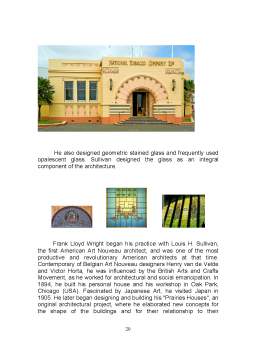Extras din referat
Art Nouveau (French for 'new art') is an international style of art, architecture and design that peaked in popularity at the turn of the 20th century(1890―1905) and is characterized by highly-stylized, flowing, curvilinear designs often incorporating floral and other plant-inspired motifs. Art Nouveau was a response to the radical changes caused by the rapid urban growth and technological advances that followed the Industrial Revolution. This timeline establishes a counterpoint between major moments in the development of Art Nouveau and world events to provide a context for understanding the style's many and varied influences.
The design style is recognized during a fifteen year period and in several of western European centers, but the influence of the design language is recognized beyond the time and place of the original Art Nouveau. Art Nouveau was more than a mere style. It was a way of attempt to redefine the meaning and nature of the work of art.
Like Impressionism, Art Nouveau was a rebellion against classical and traditional art. The movement was very successful in going beyond the borders of fine art and spreading into commercial and decorative arts.
From that time on, it was the duty of art not to overlook any everyday object, no matter how utilitarian it might be. This approach was considered completely new and revolutionary, thus the New Art - Art Nouveau name.
Art Nouveau is the French/Belgian name of an art movement in reaction to the schools at the end of the 19th century (1894-1914). This movement was represented in Europe and also in the United States. It often had several names each country. Some were named after major artists, magazines or firms. Other more general referred to something new ("Art Nouveau" in France, Modernism in Spain). In each country, "Art Nouveau" had its own identity, and sometimes artists at that time were opposed to each other.
However, beyond these "oppositions" between countries or even artists, we can find, retrospectively, numerous common points in each movement. By "Art Nouveau", I mean all the avant-garde movements during the period 1894-1914 in reaction to the academic and historical point of view.The Art Nouveau style appeared in the early 1880s and was gone by the eve of the First World War. For a brief, brilliant moment, Art Nouveau was a shimmering presence in urban centers throughout Europe and North America. It was the style of the age--seen on public buildings and advertisements, inside private homes and outside street cafés--adorning the life of the city.
Art Nouveau was a response to the radical changes caused by the rapid urban growth and technological advances that followed the Industrial Revolution. This timeline establishes a counterpoint between major moments in the development of Art Nouveau and world events to provide a context for understanding the style's many and varied influences.
An artist should work on everything from architecture to furniture design so that art would become a part of everyday life. By making beauty and harmony a part of everyday life, artists make people's lives better. This approach has been represented in painting, architecture, furniture, glassware, graphic design, jewelry, pottery, metalwork, and textiles and sculpture. Advertising posters were welcomed into art, and fence has been proclaimed a suitable exhibition place for this new art. This was a sharp contrast to the traditional separation of art into the distinct categories of fine art (painting and sculpture) and applied arts (ceramics, furniture, and other practical objects).
Characteristics of Art Nouveau
Dynamic, undulating, and flowing, with curved 'whiplash' lines of syncopated rhythm, characterized much of Art Nouveau. Another feature is the use of hyperbolas and parabolas in windows, arches, and doors .Art Nouveau in architecture and interior design eschewed the eclectic revival styles of the Victorian era.
Though Art Nouveau designers selected and 'modernized' some of the more abstract elements of Rococo style, such as flame and shell textures, they also advocated the use of highly stylized organic forms as a source of inspiration, expanding the 'natural' repertoire to embrace seaweed, grasses and insects.
Japanese wood-block prints, with their curved lines, patterned surfaces, contrasting voids, and flatness of visual plane, also inspired Art Nouveau.
Art Nouveau is considered a 'total' style, meaning that it encompasses a hierarchy of scales in design — architecture, interior design, decorative arts, furniture, textiles, household silver and other utensils, and lighting and the range of visual arts.
Art Nouveau artists wanted to erase the distinction between major and minor arts. They aimed at unifying all arts, centering them on man and his life. Therefore architecture, which has a direct influence on man's life, was the central art on which every skill is naturally integrated. Architecture is seen as a total art; every detail, every object in or on the building is related to the whole Art nouveau buildings have many of these features: asymmetrical shapes ,extensive use of arches and curved forms, curved glass, curving, plant-like embellishments, mosaics, stained glass and Japanese motif.
Preview document
Conținut arhivă zip
- Art Nouveau.doc





































